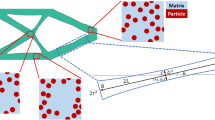Abstract
Microtexture regions (MTR) are collections of grains with similar crystallographic orientation; their presence in aerospace components can significantly impact component life. Thus, a method to detect and characterize MTR is needed. A potential solution is to use eddy current testing, which is sensitive to local changes in crystallographic orientation, to determine the size and dominant orientation of MTR. In this work, we introduce a technique that combines a variant of the matching component analysis algorithm with level set inversion in order to characterize MTR using eddy current testing data. The method is applied to simulated eddy current testing data of a real titainum specimen. Using this technique, we are able to successfully determine the boundaries and average orientation of MTR in the specimen.













Similar content being viewed by others
Data Availability
The code and data from this work can be made available upon reasonable request.
References
Harr, M., Pilchak, A., Semiatin, L.: Titanium microtexture 101—part I. Adv. Mater. Process. 179(3), 14–18 (2021)
Harr, M., Pilchak, A., Semiatin, L.: Titanium microtexture 101—part II. Adv. Mater. Process. 179(6), 13–18 (2021)
Qui, J., Ma, Y., Lei, J., Liu, Y., Huang, A., Rugg, D., Yang, R.: A comparative study on dwell fatigue of Ti-6Al-2Sn-4Zr-xMo (x = 2 to 6) alloys on a microstructure-normalized basis. Metall. Mater. Trans. A 45, 6075–6087 (2014)
Pilchak, A., Hutson, A., Porter, J.W., Buchanan, D., John, R.: On the cyclic fatigue and dwell fatigue crack growth response of Ti-6Al-4V. In: Proceedings of the 13th World Conference on Titanium, pp. 993–998 (2016)
Tucker, J.C., Groeber, M.A., Semiatin, L.S., Pilchak, A.: Synthetic building and targeted analysis of life-limiting microtextured regions. In: Proceedings of the 13th World Conference on Titanium, pp. 1913–1918 (2016)
Clum, C., Mixon, D., Scarnati, T.: Matching component analysis for transfer learning. SIAM J. Math. Data Sci. 2, 309–334 (2020)
Groeber, M., Jackson, M.: DREAM.3D: a digital representation environment for the analysis of microstructure in 3D. Integr. Mater. Manuf. Innov. 3(1), 56–72 (2014)
Randle, V., Engler, O.: Introduction to Texture Analysis: Macrotexture, Microtexture, and Orientation Mapping. Gordon and Breach Science Publishers, Philadelphia (2000)
Cherry, M., Sathish, S., Mooers, R., Pilchak, A., Grandhi, R.: Modeling of the change of impedance of an eddy current probe due to small changes in host conductivity. IEEE Trans. Magn. 53(5), 1–10 (2017)
Lorenzo, N., O’Rourke, S., Scarnati, T.: Covariance-generalized matching component analysis for data fusion and transfer learning. arXiv:2110.13194
Santosa, F.: A level-set approach for inverse problems involving obstacles. ESAIM 1 (1996)
Iglesias, M., Lu, Y., Stuart, A.: A Bayesian level set method for geometric inverse problems. Interfaces Free Bound. 18 (2016)
Dunlop, M., Iglesias, M., Stuart, A.: Hierarchical Bayesian level set inversion. Stat. Comput. 27 (2017)
Del Moral, P., Doucet, A., Jasra, A.: An adaptive sequential Monte Carlo method for approximate Bayesian computation. Stat. Comput. 22, 1009–1020 (2012)
Marjoram, P., Molitor, J., Plagnol, V., Tavare, S.: Markov Chain Monte Carlo without likelihoods. Proc. Natl. Acad. Sci. 100, 15324–15328 (2003)
Sisson, S.A., Fan, Y.: Likelihood-free Markov Chain Monte Carlo. In: Brooks, S., Gelman, A., Jones, G.L., Meng, X. (eds.) Handbook of Markov Chain Monte Carlo, pp. 313–335. Chapman and Hall, New York (2011)
Suunnaker, M., Busetto, A.G., Numminen, E., Corander, J., Foll, M., Dessimoz, C.: Approximate Bayesian computation. PLoS Comput. Biol. 9, 1002803 (2013)
Marin, J.M., Pudlo, P., Robert, C.P., Ryder, R.J.: Approximate Bayesian computational methods. Stat. Comput. 22, 1167–1180 (2012)
Balanis, C.A.: Advanced Engineering Electromagnetics. Wiley, New Jersey (2012)
Aulder, B.A., Moulder, J.C.: Review of advances in quantitative eddy current nondestructive evaluation. J. Nondestr. Eval. 18(1), 3–36 (1999)
Niezgoda, S., Glover, J.: Unsupervised learning for efficient texture estimation from limited discrete orientation data. Metall. Mater. Trans. A 44A, 4891–4905 (2013)
Acknowledgements
The authors would like to acknowledge support from the Air Force Office of Scientific Research (AFOSR) through grant 21RXCOR037 under the Dynamic Data and Information Processing (DDIP) program. In addition, Dr. Homa and Dr. Lorenzo would like to acknowledge support from the Air Force Research Laboratory (AFRL) through contract FA8650-19-F-5231.
Funding
This work has been funded through the Air Force Office of Scientific Research (AFOSR) through Grant 21RXCOR037 under the Dynamic Data and Information Processing (DDIP) program. In addition, funding was provided through the Air Force Research Laboratory (AFRL) under Contract FA8650-19-F-5231.
Author information
Authors and Affiliations
Contributions
LH wrote the majority of the manuscript text and generated all figures. NL developed the CGMCA algorithm and wrote Sect. 2.2. MC developed the AII model and wrote Sect. 3.1. JW wrote the introduction and contributed background information and references.
Corresponding author
Ethics declarations
Conflict of interest
On behalf of all authors, Dr. Homa states that the authors have no competing interests.
Consent for Publication
All authors have consented to have this work published and have approved of submission to the Journal of Nondestructive Evaluation.
Consent to Participate
Not applicable.
Ethical Approval
Not applicable.
Additional information
Publisher's Note
Springer Nature remains neutral with regard to jurisdictional claims in published maps and institutional affiliations.
Rights and permissions
Springer Nature or its licensor (e.g. a society or other partner) holds exclusive rights to this article under a publishing agreement with the author(s) or other rightsholder(s); author self-archiving of the accepted manuscript version of this article is solely governed by the terms of such publishing agreement and applicable law.
About this article
Cite this article
Homa, L., Lorenzo, N., Cherry, M. et al. Microtexture Region Segmentation Using Matching Component Analysis Applied to Eddy Current Testing Data. J Nondestruct Eval 42, 39 (2023). https://doi.org/10.1007/s10921-023-00951-z
Received:
Accepted:
Published:
DOI: https://doi.org/10.1007/s10921-023-00951-z




